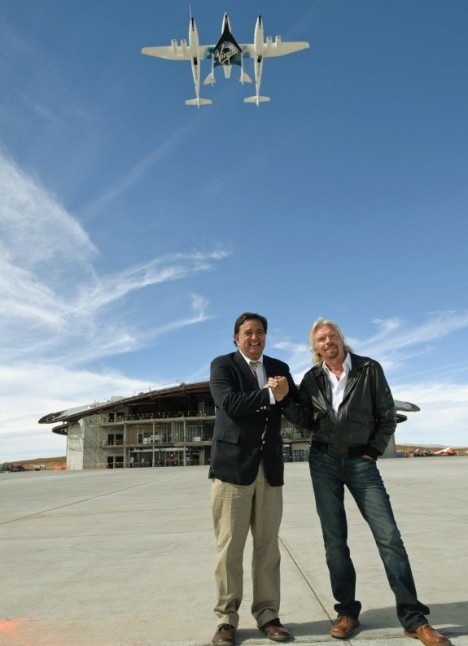Runway unveiled for world’s first ‘tourist’ spaceship
The world’s first commercial passenger spaceship moved a step closer to takeoff, as Richard Branson unveiled a new runway at a remote New Mexico spaceport. Branson and New Mexico Governor Bill Richardson on Friday hosted a ceremony marking the completion of the main runway at Spaceport America, near the town of Las Cruces where the […]

The world’s first commercial passenger spaceship moved a step closer to takeoff, as Richard Branson unveiled a new runway at a remote New Mexico spaceport.
Branson and New Mexico Governor Bill Richardson on Friday hosted a ceremony marking the completion of the main runway at Spaceport America, near the town of Las Cruces where the Virgin Galactic project is based.
“This is the beginning of the second space age and we are proud to have been supporters of this part of the story.
“From here we will see, perhaps daily flights into space, but also scientists, explorers of new opportunities beyond our planet,” he told reporters.
Buzz Aldrin, the second man to set foot on the moon, told AFP: “I am very happy that civilians will be able to reach space. I’d like to be one of the passengers on these flights, of course.”
SpaceShipTwo, a six-seat craft which is scheduled to carry paying customers into suborbital space by early 2012, made its maiden flight above the Californian desert in March.
On Friday the aircraft — re-named the VSS Enterprise — flew high above the new two-mile (3.2-kilometer) long, 200-foot (60-meter) wide runway in tandem with its mothership, WhiteKightTwo or Eve.
The space ship is 60 feet (18 meters) long and its cabin is similar in size to a Falcon 900 executive jet, “allowing maximum room for the astronauts to float in zero gravity,” according to the company.
Guests for Friday’s ceremony included people who have already paid deposits and are just waiting for the day they go into space.
Virgin started taking deposits from people wanting to become astronauts in 2005, and has now collected 50 million dollars in deposits from more than 380 people willing to pay the 200,000 dollar ticket price, said Branson.
“Two hundred thousand dollars is a lot of money, but I think it’s a fair price for this life experience,” said New Zealand entrepreneur Devek Handley, 32.
Russian Igor Kutsenko, 36, an advertising company boss, said he plans to go into space with his 57-year-old mother and 59-year-old father.
“We will travel together as soon as Virgin Galactic makes space travel a reality. This has been the dream of my life,” he said, adding that he had paid a deposit of 150,000 dollars each.
When it takes off, WK2 will carry SpaceShipTwo to an altitude of around 50,000 feet (15 kilometers) before dropping the smaller spaceship and allowing it to fire up its rocket motor to blast up to the brink of space.
Once it has reached suborbital space, SpaceShipTwo passengers will be able to view the Earth from portholes next to their seats, or unbuckle their seatbelts and float in zero gravity.
Branson said that, while initially the spaceship will remain suborbital, “in time we’ll go to orbital flights. And, you know, one day … we hope to build a hotel in space,” he added.
Virgin officials are “also thinking about intercontinental travel at a fraction of the time that it currently takes to go from, you know, say America to Australia.”
Governor Richardson added: “In about 10 years we will probably be making transcontinental flights in amazing period of time, like going to Russia in less than two hours.”
Branson is also planning to take his mum and dad into space.
“I suppose one of the privileges of owning the spaceship company is I’m able to take my family up,” said Branson. “So my father and mother keep saying ‘hurry up,’ because they’re entering their 90s now.”
His parents “very much want to go. And obviously, being weightless with the aches and pains they won’t have to worry about. They’ll be floating about,” added the British entrepreneur.
But safety is paramount, he insisted. “We’ll do many, many, many test flights over the next 12 months to maybe 18 months before we actually send people up into space.
“But we’re entering the last stages of the test program and we can see the light at the end of the tunnel now,” he added.
Source: AFPrelaxnews





